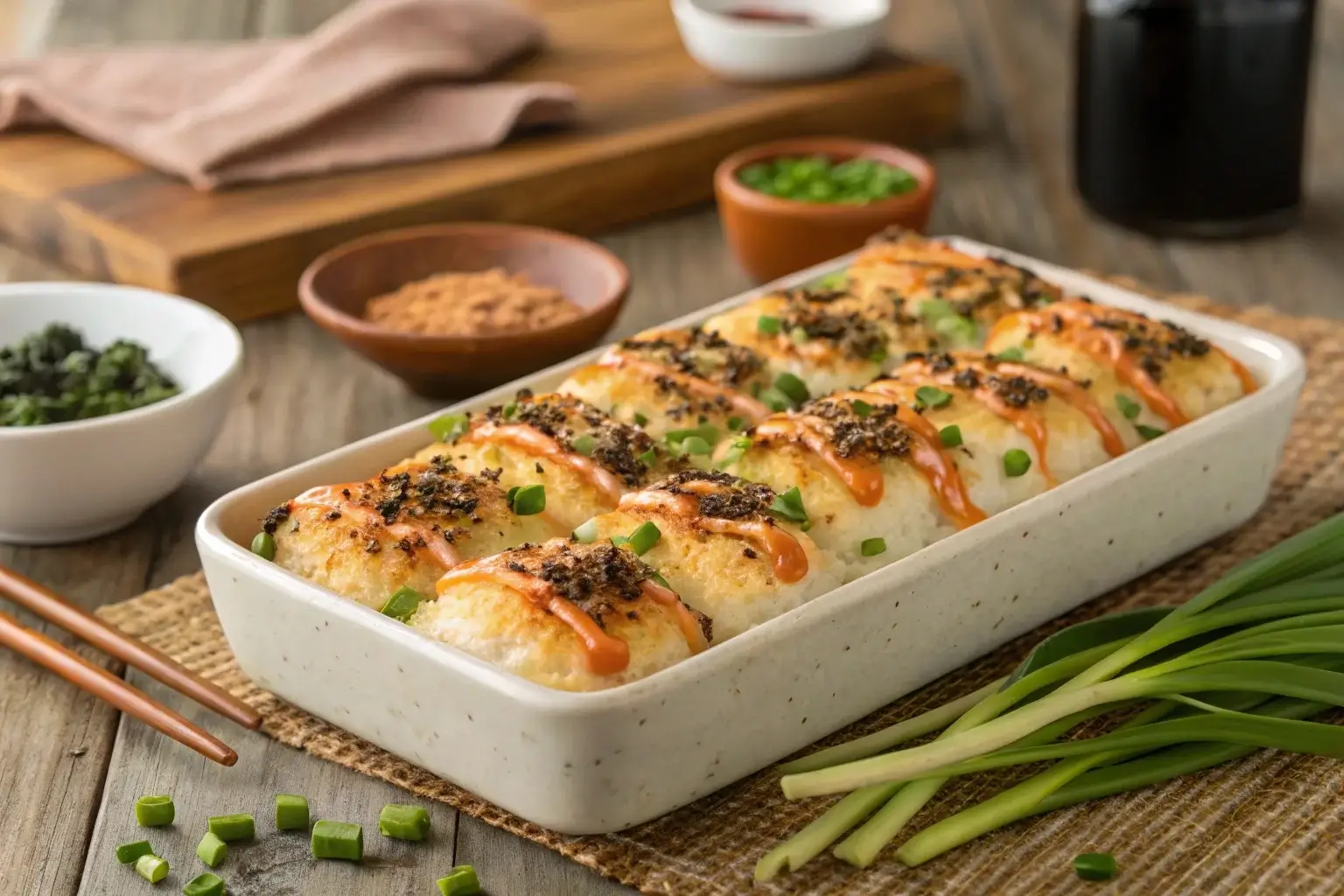Sushi bake is the ultimate comfort food for sushi lovers, combining the flavors of traditional sushi rolls with the warm, creamy texture of a casserole. Originating as a lockdown food trend, it’s now a staple at gatherings, potlucks, and family dinners. This layered dish features seasoned rice, seafood, and creamy sauces baked to perfection, making it a fun and delicious twist on sushi. Whether you’re a beginner or an experienced cook, this guide will walk you through everything from the history and essential ingredients to variations and serving tips.
The first time I made sushi bake with Momo, it was an adventure filled with laughs and tasty experiments. We were craving sushi but didn’t want the hassle of rolling individual pieces, so Momo suggested we try making this trendy baked version. Our kitchen quickly turned into a lively mess—rice stuck to the counters, sauce drizzles everywhere, and Momo sneakily eating crab straight from the bowl. By the time the casserole came out of the oven, the aroma of warm rice, seaweed, and spicy mayo filled the room. We grabbed our nori sheets, scooped generous portions, and couldn’t stop eating. That night, we realized how fun and easy sushi bake is, and it’s been a go-to dish ever since.
Table of Contents
Introduction to Sushi Bake
What is Sushi Bake, and Why Has It Become So Popular?
Sushi bake is a modern take on traditional sushi that has captured the hearts of food lovers worldwide. This comforting casserole combines layers of seasoned rice, seafood, creamy sauces, and toppings like furikake, creating a warm, delicious dish that’s easy to make and share. Known for its rich flavor and versatility, sushi bake is a popular choice for family dinners, potlucks, and casual gatherings. Unlike traditional sushi rolls, it doesn’t require expert rolling skills, making it perfect for beginners.
The dish became a viral sensation during the pandemic, as people craved creative yet simple meals they could prepare at home. Whether you enjoy classic California roll flavors or prefer to experiment with spicy sauces and different proteins, sushi bake offers endless customization options to satisfy your taste buds.
Origins and History of Sushi Bake
How Sushi Bake Evolved from Traditional Sushi
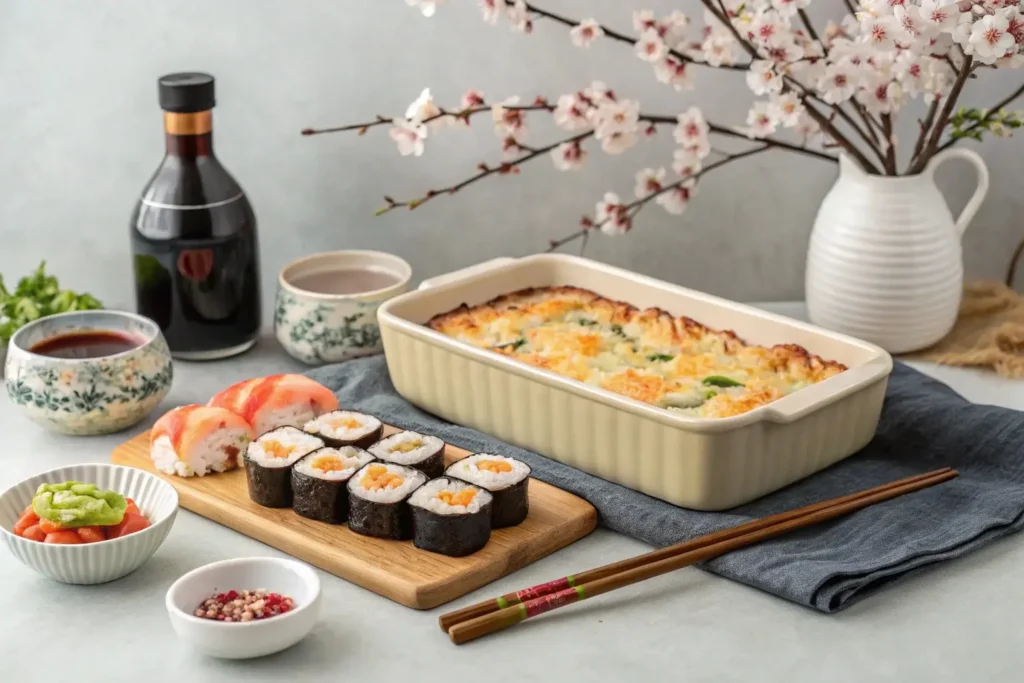
Sushi bake is believed to have originated in the Philippines, where innovative cooks combined sushi flavors into a baked casserole. Taking inspiration from Japanese sushi rolls—particularly the popular California roll—it transformed into an easy, shareable dish. The Filipino twist, using ingredients like Kewpie mayo, cream cheese, and imitation crab, quickly spread across social media platforms and gained global popularity.
Unlike traditional sushi, which requires precise rolling and presentation, sushi bake delivers the same umami-packed flavors with less effort. Its fusion of Japanese and Filipino influences has turned it into a household favorite for those seeking a mix of tradition and convenience.
Its adaptability and ability to feed a crowd have made it a favorite not only in Filipino communities but also across the globe.
Essential Ingredients for Making the Best Sushi Bake
The Foundation: Sushi Rice
The base of any great sushi bake is perfectly cooked sushi rice. Use short-grain or medium-grain rice for the best texture, as these varieties are stickier and hold together better. Season the cooked rice with rice vinegar, sugar, and salt to give it that classic sushi flavor. Fluff the rice gently with a fork to avoid clumping.
Protein Options: Crab, Salmon, or Tuna
Imitation crab (kani) is the most common protein used in sushi bake, mimicking the flavors of a California roll. However, you can switch it up with flaked salmon, cooked shrimp, or seared tuna. If you’re feeling adventurous, try mixing proteins for a richer flavor profile. For vegetarian versions, tofu or marinated mushrooms work as great alternatives.
Creamy and Flavorful Sauces
The signature creaminess of sushi bake comes from combining Kewpie mayo (a Japanese-style mayonnaise) with cream cheese and a touch of soy sauce. For a spicy kick, drizzle spicy mayo over the top before baking. The sauces not only bind the ingredients but also provide a melt-in-your-mouth texture.
Toppings and Flavor Enhancers
No sushi bake is complete without toppings. Sprinkle furikake (a Japanese rice seasoning blend) on top to add texture and umami. Additional toppings like sesame seeds, nori (seaweed), avocado slices, or thinly sliced cucumbers elevate the dish. A drizzle of eel sauce or soy sauce at the end can provide the perfect finishing touch.
With the right ingredients, you’ll have everything you need to create a rich, satisfying, and customizable sushi bake.. (For more rice dishes or seafood recipes inspiration, check out this Beef Pepper Rice Homemade Tips — for flavorful rice casseroles.)
Step-by-Step Recipe for Classic Sushi Bake
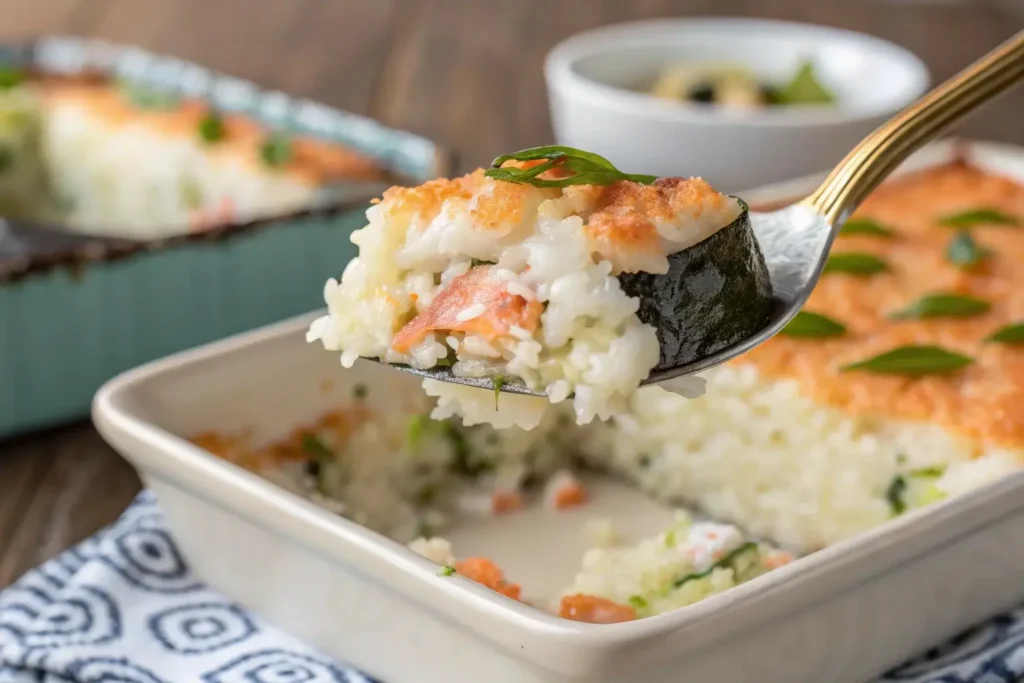
Step 1: Cooking and Seasoning the Rice
Start by cooking 2 cups of short-grain or sushi rice according to package instructions. Once cooked, transfer it to a large mixing bowl and let it cool slightly. While the rice is still warm, season it with a mixture of 1/3 cup rice vinegar, 2 tablespoons sugar, and 1 teaspoon salt. Gently fold the seasoning into the rice using a spoon or rice paddle. Be careful not to mash the rice.
Step 2: Preparing the Seafood Filling
In a medium bowl, mix 1 cup of shredded imitation crab (or flaked cooked salmon) with 1/2 cup Kewpie mayo, 2 tablespoons cream cheese, 1 tablespoon soy sauce, and 1 teaspoon sriracha for a bit of heat. Stir until the mixture is creamy and evenly coated. Adjust seasoning as needed—feel free to add more sriracha if you prefer a spicier kick.
Step 3: Layering the Sushi Bake
Preheat the oven to 375°F (190°C). Lightly grease a 9×9-inch baking dish. Spread the seasoned rice evenly at the bottom of the dish, creating a solid base. Add the creamy seafood mixture as the second layer, making sure it covers the rice evenly. For added flavor, sprinkle a generous amount of furikake seasoning on top.
Step 4: Baking the Dish
Place the dish in the preheated oven and bake for 15-20 minutes or until the top is golden and bubbly. Keep an eye on it to ensure the top doesn’t burn.
Step 5: Garnishing and Serving
Once out of the oven, garnish with thinly sliced green onions, sesame seeds, and an optional drizzle of spicy mayo or eel sauce. Serve with nori sheets on the side, allowing everyone to scoop their own servings onto the seaweed.
Tips for Perfecting Sushi Bake
Tips for Amateur Cooks
- Keep It Simple: Stick to basic ingredients like sushi rice, imitation crab, and Kewpie mayo for your first attempt. Once you’re confident, you can experiment with more flavors.
- Use Day-Old Rice: Slightly dry rice works best because it won’t turn mushy when baked.
- Spread the Layers Evenly: Make sure the rice and seafood layers are evenly distributed to get a well-balanced bite every time.
- Taste Before Baking: Always taste the seafood mixture before layering to adjust seasoning as needed.
- Don’t Skip the Furikake: This seasoning is key to enhancing the dish’s umami flavor.
Tips for Advanced Cooks
- Experiment with Proteins: Try mixing different seafood, like salmon, shrimp, and scallops, for a gourmet twist.
- Infuse the Rice: Add a touch of dashi or kombu broth to the rice while cooking to give it an extra depth of flavor.
- Use Homemade Sauces: Instead of store-bought spicy mayo, create your own by blending Kewpie mayo, sriracha, and a hint of sesame oil.
- Try a Panko Topping: Sprinkle panko breadcrumbs on top for a crunchy crust that contrasts beautifully with the creamy interior.
- Torch the Top: For an elevated presentation, lightly torch the top after baking to caramelize the sauce and give it a smoky flavor.
By following these tips, you’ll be able to master sushi bake and customize it to your taste, making it a favorite dish for all skill levels.
Variations of Sushi Bake
Salmon Sushi Bake with Honey Glaze
Replace imitation crab with flaked cooked salmon and add a honey-soy glaze for a sweet and savory twist. Simply brush the glaze on the salmon before mixing it with mayo and cream cheese. The honey caramelizes slightly during baking, adding a rich depth of flavor.
Tuna Sushi Bake with Spicy Mayo
For tuna lovers, swap the crab for canned or seared tuna. Increase the amount of sriracha in the mixture to make the dish spicier. Drizzle more spicy mayo on top before serving to enhance the heat.
Vegetarian Sushi Bake with Tofu and Avocado
For a meat-free option, replace the protein with firm tofu and thinly sliced avocado. Marinate the tofu in soy sauce and sesame oil before combining it with the creamy mayo mixture. The avocado adds a buttery texture that complements the seasoned rice perfectly.
Low-Carb Sushi Bake with Cauliflower Rice
Swap the sushi rice for cauliflower rice for a low-carb version of this dish. Lightly sauté the cauliflower rice with a bit of garlic and sesame oil before layering it in the baking dish. This variation is ideal for keto and health-conscious eaters.
Keto-Friendly Option with Cream Cheese and Shrimp
Combine cream cheese, shrimp, and soy sauce for a keto-friendly twist. Layer this rich mixture over a bed of cauliflower rice and top it with extra cheese for a bubbly, satisfying result.
With these variations, you can tailor sushi bake to suit any dietary preference or flavor craving.
Health Considerations and Nutritional Benefits of Sushi Bake
Although sushi bake is known for its indulgent and rich flavors, it can also provide several nutritional benefits, especially when balanced with the right ingredients. Here’s what you should know to enjoy this dish guilt-free.
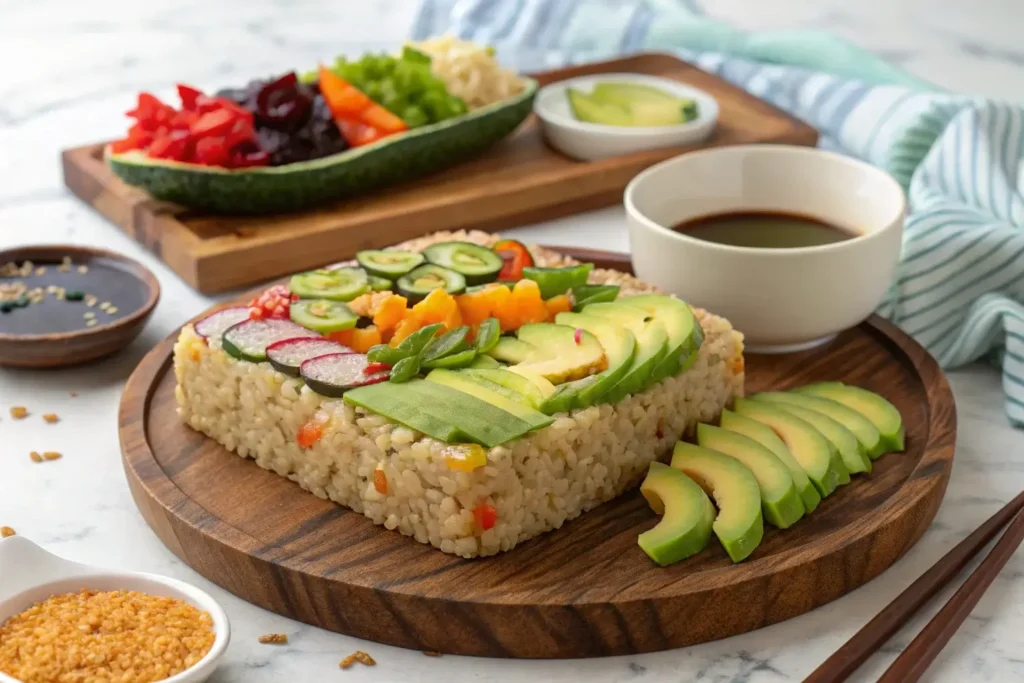
Protein and Omega-3 Fatty Acids
Many versions of sushi bake use seafood, such as salmon, tuna, or crab, which are excellent sources of protein. Salmon and tuna are especially rich in omega-3 fatty acids, which are essential for heart health and brain function. For those following a plant-based diet, tofu offers a solid protein alternative.
Healthy Carbohydrates from Rice
Traditional sushi rice provides carbohydrates to fuel your body, but you can opt for healthier versions by swapping white rice for brown rice or quinoa. Brown rice offers additional fiber, which aids in digestion and helps you feel full for longer.
Lower-Calorie and Low-Carb Alternatives
For those watching their calorie intake or following a low-carb diet, cauliflower rice is a great substitute for traditional sushi rice. It’s low in carbohydrates and calories but still provides the satisfying texture needed to support the other layers of the dish. Reducing the amount of cream cheese and mayonnaise used can also help lower the dish’s fat content.
Controlling Sodium and Fat
To keep sodium levels in check, opt for low-sodium soy sauce and reduce added salt. Additionally, switching from regular mayonnaise to light or vegan options can help cut down on fat without sacrificing flavor. Adding fresh vegetables like cucumbers, avocados, or carrots further boosts the nutritional profile.
By tweaking a few key ingredients, you can enjoy a delicious sushi bake without compromising your health goals.
Serving Suggestions and Pairings for Sushi Bake
Sushi bake is incredibly versatile and pairs well with a variety of sides and garnishes that can enhance its flavor. Whether you’re serving it at a party or a casual dinner, these ideas will ensure your meal is a hit.
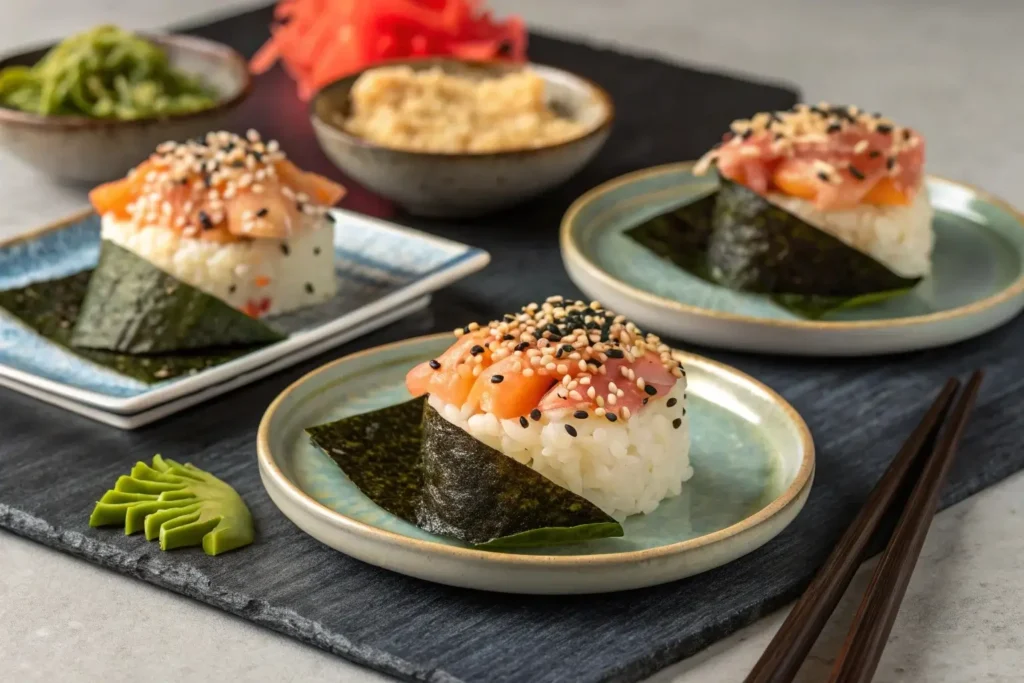
Seaweed Sheets for Scooping
Traditionally, sushi bake is served with roasted nori sheets. Simply scoop a portion of the baked casserole onto a sheet of nori and eat it like a taco. The crisp, salty seaweed perfectly complements the creamy filling and seasoned rice.
Pickled Ginger and Wasabi for an Authentic Touch
To give your sushi bake a more authentic sushi experience, serve it with pickled ginger and a small side of wasabi. The pickled ginger provides a zesty contrast, while the wasabi adds a bit of heat for those who like their food spicy.
Side Dishes That Pair Well
- Miso Soup: The light, savory broth of miso soup is a perfect way to balance the richness of the sushi bake.
- Japanese Cucumber Salad: A fresh cucumber salad with sesame dressing adds crunch and acidity, making it a refreshing companion to the dish.
- Steamed Edamame: Lightly salted edamame is a simple side that complements the savory umami flavors of the baked sushi.
Garnishing Tips
Enhance the presentation with garnishes like thinly sliced green onions, sesame seeds, or a drizzle of spicy mayo or eel sauce. These finishing touches not only add flavor but also make the dish visually appealing.
With these serving suggestions, your sushi bake will be a well-rounded and flavorful meal suitable for any occasion.
Common Mistakes to Avoid When Making Sushi Bake
Even though sushi bake is a relatively simple dish, a few common mistakes can affect its taste and texture. Here’s what to watch out for to ensure a delicious, perfectly baked casserole every time.
Using the Wrong Type of Rice or Overcooking It
One of the most critical components of sushi bake is the rice. Using long-grain rice instead of short-grain or sushi rice will result in a dish that lacks the desired sticky texture. Additionally, overcooked rice can turn mushy, making the casserole lose its structure. To avoid this, cook the rice according to instructions and let it rest before layering.
Overloading the Casserole with Sauces
While the creamy mayo and cheese sauces are essential to sushi bake, too much can overwhelm the dish and make it greasy or soggy. Strike a balance by using just enough to bind the ingredients and add flavor without overpowering the other layers.
Not Balancing Flavors Properly
A well-balanced sushi bake should have the right mix of savory, tangy, and umami flavors. Adding too much rice vinegar can make the rice overly tangy, while not enough soy sauce or furikake may leave the dish bland. Taste as you go to ensure each layer is well-seasoned.
Skipping the Resting Period After Baking
Letting the casserole rest for a few minutes after baking helps the layers settle and makes it easier to serve. Skipping this step can cause the rice and filling to fall apart when scooped.
By avoiding these mistakes, you’ll achieve a rich, satisfying sushi bake that’s perfectly textured and flavorful.
Storing and Reheating Leftovers
Leftover sushi bake is just as delicious the next day, provided it’s stored and reheated correctly. Follow these tips to maintain its freshness and flavor.
Proper Storage Techniques
After serving, allow any leftovers to cool completely before transferring them to an airtight container. This prevents condensation and sogginess. Store the leftovers in the refrigerator for up to 3 days. If you want to store them for longer, freezing is an option, although the texture may change slightly. Divide the dish into individual portions before freezing for easier reheating.
Reheating for the Best Texture
- Oven Method: For the best results, reheat the sushi bake in the oven at 350°F (175°C) for about 10-12 minutes. Cover the dish with foil to prevent it from drying out.
- Microwave Method: If you’re short on time, the microwave works too. Place a portion on a microwave-safe plate, cover it with a damp paper towel, and heat in 30-second intervals until warm.
- Adding Fresh Toppings: To revive the flavors, add fresh toppings such as sliced green onions, furikake, or a drizzle of spicy mayo before serving.
Can You Freeze Sushi Bake?
Yes, you can freeze sushi bake, but be aware that the rice may become slightly drier once thawed. To combat this, drizzle a little soy sauce or sesame oil over the rice before reheating.
With proper storage and reheating, you can enjoy the flavors of sushi bake long after it comes out of the oven.
Frequently Asked Questions (FAQ)
1. What type of rice is best for sushi bake?
The best rice for sushi bake is short-grain or sushi rice. These varieties have a sticky texture that holds the layers together, making it easier to scoop and serve. Avoid long-grain rice, as it tends to be drier and less cohesive.
2. Can you make sushi bake ahead of time?
Yes, you can prepare sushi bake ahead of time. Assemble the layers, cover the dish tightly with plastic wrap or foil, and store it in the fridge for up to 24 hours before baking. When ready to serve, simply pop it in the oven and bake as directed.
3. What are some alternatives to imitation crab?
If you don’t want to use imitation crab, you can substitute it with cooked salmon, tuna, shrimp, or even shredded chicken for a different flavor profile. Vegetarians can use tofu or marinated mushrooms for a plant-based alternative.
4. Is sushi bake healthy?
Sushi bake can be a healthy option depending on the ingredients used. By opting for brown rice or cauliflower rice, lean proteins like salmon or shrimp, and reducing the amount of mayonnaise and cream cheese, you can create a lighter version of the dish.
Why You Should Try Sushi Bake Today
Sushi bake is more than just a trendy dish—it’s a convenient, flavorful, and customizable way to enjoy sushi-inspired flavors without the need for expert rolling skills. Its layers of seasoned rice, creamy seafood, and umami-packed toppings come together to create a warm, comforting meal that’s perfect for any occasion.
Whether you’re preparing it for a family dinner, potluck, or weekend treat, sushi bake is versatile enough to fit any event. Its simplicity makes it a hit with beginner cooks, while experienced chefs can experiment with bold flavors and creative toppings.
The dish’s growing popularity stems from its ability to bring people together, much like traditional sushi does. Once you try it, you’ll see why it’s become a staple in so many households. So, roll up your sleeves and get baking—you’re in for a treat!
